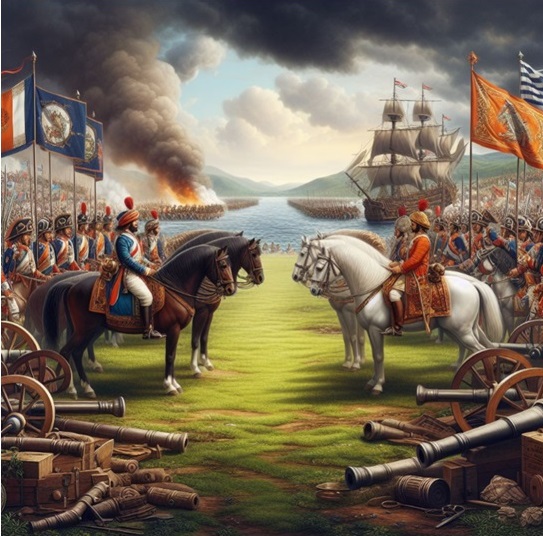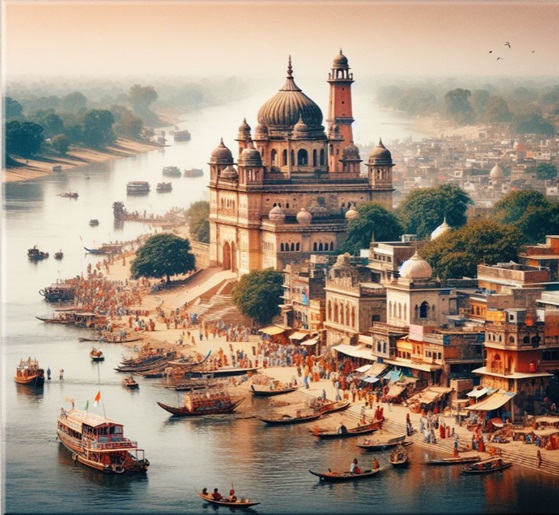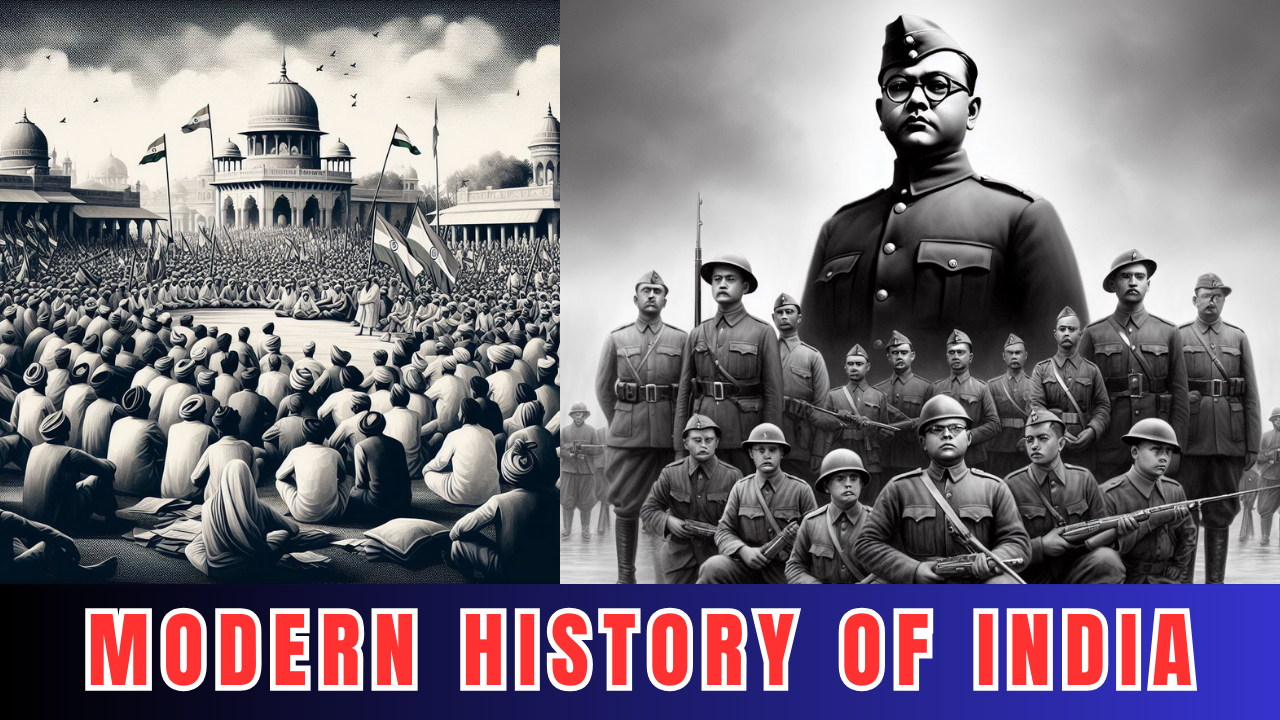In this comprehensive “Modern History of India”, we unravel the key events, personalities, and movements that have shaped the nation’s trajectory from colonial rule to independence and beyond.
Whether you’re a student preparing for exams or an enthusiast keen on understanding India’s past, this blog post offers a structured approach to learning. Each MCQ is meticulously crafted to test your knowledge and deepen your understanding of significant historical milestones.
From the Indian National Movement and the struggle for independence to the challenges and triumphs post-independence, our MCQs cover a wide array of topics. Test your knowledge of iconic figures like Mahatma Gandhi, Jawaharlal Nehru, and Subhas Chandra Bose, and gain insights into pivotal events such as the Partition of India, and the formation of the Indian Constitution.
Unlock the secrets of India’s modern history and enhance your learning experience with our MCQ guide. Whether you’re studying solo or organizing group quizzes, the topic on “Modern History of India” is one of the most important topics. This resource is designed to cater to all learners, providing a fun and interactive way to engage with India’s past.
1. Who was responsible for raising the flag of Azad Hind (Free India) in liberated India for the first time?
A. Mahatma Gandhi
B. Jawaharlal Nehru
C. Colonel Shaukat Hayat Malik

2. What was the main objective of the Government of India Act (1935)?
A. To grant full independence to India
B. To establish a federal system in India
C. To strengthen British control over India
3. Who was the founder of the Hindustan Republican Association?
A. Bhagat Singh
B. Chandrashekhar Azad
C. Ram Prasad Bismil
[The Hindustan Republican Association (HRA), a revolutionary organization founded in India during the early 20th century, specifically in 1924, emerged as a response to the oppressive British colonial rule.]
4. The Battle of Plassey was fought in the year?
A. June 23, 1757
B. June 16, 1754
C. June 29, 1759
[In present-day West Bengal, India. It was a pivotal moment in Indian history and marked the beginning of British colonial rule in India.It was led by Robert Clive against the force of Siraj-ud-Daulah]

5. Who was the last Governor-General of India under the Government of India Act (1935)?
A. Lord Mountbatten
B. Lord Linlithgow
C. Lord Wavell
6. Who were the key parties involved in the Treaty of 1760 in India?
A. Mahatma Gandhi and Jawaharlal Nehru.
B. Madan Mohan Malaviya and Dr. B.R. Ambedkar.
C. Mir Kasim and the East India Company.
7. Who was the last Mughal emperor during the Mutiny of 1857?
A. Bahadur Shah Zafar
B. Akbar II
C. Shah Alam II
8. The Battle of Buxar between whom and when?
A. October 20, 1789
B. October 13, 1821
C. October 22, 1764
9. During the period of the battle of Buxar, who was the governor?
A. Lord William
B. Robert Clive
C. Lord Lytton (1876-1880)
10. What did the Treaty of Allahabad transfer to the East India Company?
A. Tax collecting rights in Bengal, Bihar, and Orissa.
B. Control over the Mughal Empire.
C. Exclusive trade privileges with China.

11. Who handed over the Treaty of Allahabad to Robert Clive?
A. Emperor Akbar
B. Emperor Shah Alam
C. Emperor Aurangzeb
12. Which of the following treaty was signed after the end of the First Anglo-Mysore War (1767-69)?
A. Treaty of Madras
B. Treaty of Mangalore
C. Treaty of Seringapatam
[this treaty provide for the exchange of prisoners and mutual restitution of conquest.Haider Ali was promised the help of the English in case he was attacked by any other power]
13. Tipu Sultan became the ruler of Mysore in which year?
A. 1765
B. 1782
C. 1775
[He was the son of Haider Ali and Fatima.He gave his support to the French soldiers at Seringapatam in setting up a Jacobin Club in 1797]
14. Which place was famous as the capital of Tipu Sultan?
A. Srirangapatna
B. Gulbarga
C. Hampi
15. In 1918, Mahatma Gandhi undertook his first major hunger strike in India. What was the primary reason for this action?
A. To protest the unfair treatment of farmers by the British government.
B. To demand a reduction in taxes levied on Indian citizens.
C. To support striking mill
View AnswerAnswer:C. To support striking mill.
[support mill workers in their fight for better wages and working conditions.It was in Ahmedabad]
15. What was the primary cause of the Kheda Satyagraha in 1918?
A. To protest against British colonial rule
B. To demand economic justice for textile mill workers
C. To advocate for religious freedom
[It was the first non-cooperation movement in Kheda, Gujrat]

Indian Civilization and Culture Question Answer
16. Which community played a central role in the Kheda Satyagraha?
A. Jute workers
B. Tea plantation laborers
C. Peasant-Patidar community
17. The Satyagraha against the Rowlatt Act is known for being the first mass strike in India. What was the official name of the Rowlatt Act?
A. The Indian Sedition Act (1918)
B. The Anarchical and Revolutionary Crimes Act of 1919
C. The Government of India Act (1935)
18. Mahatma Gandhi called for a nationwide Satyagraha against the Rowlatt Act. What did this act grant the British government the authority to do?
A. Impose higher taxes on Indian businesses.
B. Detain individuals suspected of terrorism for up to two years without trial.
C. Force Indians to serve in the British military d) Ban all public gatherings and protests.
19. The Rowlatt Act, passed in 1919 by the British Raj, is known for its harsh measures. What is MOST accurate description of the Rowlatt Act?
A. It empowered the British government to detain suspected revolutionaries without trial.
B. It increased infrastructure spending in British India.
C. It mandated free primary education for all children.
20. The Jallianwala Bagh massacre, a horrific event in Indian history, took place in which year?
A. 1910
B. 1916
C. 1919
21. Who was the British commander in charge of the troops responsible for the Jallianwala Bagh massacre?
A. Lord Curzon
B. General Reginald Dyer
C. Lord Mayo
22. Who appointed the Hunter Commission?
A. British Parliament
B. Government of India Act
C. Viceroy of India
23. What was the primary objective of the Hunter Commission?
A. To investigate the causes of the Jallianwala Bagh massacre.
B. To assess the impact of British policies on Indian agriculture.
C. To investigate the Montagu-Chelmsford Reforms.
24. Who was the last Viceroy of India under the Mountbatten Plan?
A. Lord Mountbatten
B. Lord Wavell
C. Lord Mayo
25. Who were the prominent leaders associated with the Khilafat Movement in India?
A. Muhammad Ali Jinnah and Liaquat Ali Khan
B. Muhammad Ali and Shaukat Ali
C. Subhas Chandra Bose and Bhagat Singh

